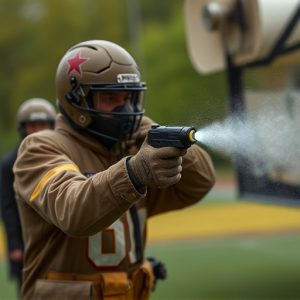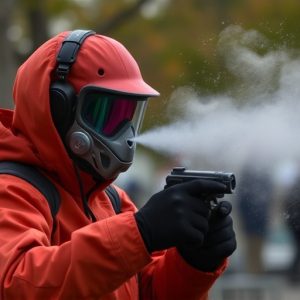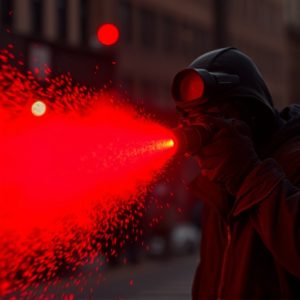Decoding Pepper Spray: Effects, Safety, and Legal Boundaries
Pepper spray is a non-lethal self-defense tool that temporarily incapacitates attackers by causing …….
Pepper spray is a non-lethal self-defense tool that temporarily incapacitates attackers by causing intense pain and temporary vision impairment through the active ingredient capsaicinoid. It affects the eyes' pain and thermal receptors, triggering a reflex that closes the eyelids and induces a burning sensation, effectively creating an opportunity for escape or intervention by law enforcement. The spray's effectiveness is contingent on proper distance management; it is most effective between 4 to 12 feet, where environmental factors such as wind and weather must be considered. Users should familiarize themselves with their specific pepper spray device, whether gel, foam, or liquid, to optimize its range and aim. Pepper spray can indeed cause temporary blindness, but this is not a permanent condition. Legal use of pepper spray is regulated by state and local laws, which users must understand to avoid legal repercussions. Ethically, the decision to use pepper spray should be made judiciously, considering both personal safety and potential collateral effects on bystanders and the environment. Understanding its science, range, and legal implications is crucial for safe and effective use of pepper spray in self-defense scenarios.
When considering personal safety, understanding the mechanics and implications of pepper spray is crucial. This article delves into the science and application of spray distance, a critical aspect that can determine the effectiveness of this self-defense tool. Exploring how factors like wind conditions and spray patterns affect visibility and range, we unravel the impact of these elements on your ability to maintain a safe distance during an encounter. Additionally, we address the legal framework and ethical considerations surrounding its use. Can pepper spray blind you? The answer lies within the intricate dynamics at play. Join us as we navigate the complexities of pepper spray’s visual disabling effects and how they can be pivotal in personal defense scenarios.
Understanding Spray Distance and Its Impact on Personal Safety
When considering personal safety products like pepper spray, understanding the spray distance is crucial for effective use and self-defense. Pepper spray is designed to incapacitate an assailant by directly impacting their eyes, face, or respiratory system with its powerful irritants. The distance at which the spray’s effects become debilitating can vary depending on factors such as wind conditions, environmental elements, and the specific formulation of the pepper spray product. Typically, a reliable self-defense spray should have a range between 4 to 12 feet, allowing users to maintain a safe distance from potential threats. This distance enables users to react and escape without physical confrontation. It’s also important to note that while pepper spray can effectively deter an attacker, it is not guaranteed to blind an individual permanently; its primary purpose is to temporarily impair vision and create a window of opportunity for escape or for authorities to intervene. Understanding the effective range of your pepper spray is essential for personal safety, as it directly influences how you should position yourself during an encounter and can significantly increase your chances of safely diffusing a dangerous situation. Users should practice with their pepper spray to familiarize themselves with its operational distance and effects, ensuring they are prepared in the event of an emergency.
The Science Behind Pepper Spray and Its Visual Disabling Effects
Capsaicin, the active component in pepper sprays, disrupts the normal operation of the eyes upon contact. When sprayed, the capsaicin molecules interact with the sensory neurons responsible for transmitting pain and thermal signals to the brain. This interaction triggers an overwhelming sensation of burning pain, which can cause involuntary eye closure due to the intense discomfort. The eyes’ natural reflex to protect themselves from irritation is to close tightly, thereby significantly reducing the victim’s visual acuity. The disabling effect of pepper spray is not limited to temporary blindness; it also impairs the ability to see clearly for a period, ranging from minutes to half an hour, depending on various factors such as wind conditions, distance from the target, and the individual’s physical state. Understanding the science behind pepper spray is crucial for its effective use in self-defense scenarios while recognizing that it can indeed induce temporary blindness, making it a potent non-lethal tool for personal protection.
Factors Influencing the Efficacy of Pepper Spray in Self-Defense Situations
The efficacy of pepper spray as a self-defense tool is influenced by several factors, each playing a critical role in its performance during critical moments. Primarily, the spray distance is a decisive element; it determines whether the spray contacts the attacker’s eyes or misses entirely. The active ingredient in pepper sprays, capsaicinoid, must reach the mucous membranes of the eyes at a potent concentration to incapacitate effectively. Users must understand the optimal range for their specific pepper spray model; this can typically be between 4 and 12 feet but varies by product design. Factors such as wind conditions, environmental factors, and personal physiology can affect the trajectory and density of the spray plume. For instance, a gust of wind could disperse the spray, reducing its potency, while a close distance might result in an insufficient dose to achieve the desired blinding effect as per the query, “Can pepper spray blind you?”. Additionally, personal factors like eye size and tear duct functionality can influence the spray’s impact. Users should practice with their pepper spray under various conditions to familiarize themselves with its range and effects, ensuring they can effectively deploy it in self-defense situations.
Another crucial aspect is the type of pepper spray chosen. There are three main types available: gel, foam, and liquid. Each has its advantages and disadvantages regarding range, aiming, and persistence on surfaces. Gel formulations, for example, offer a concentrated application that can be more effective at longer distances but may require precise aiming. Foam sprays create a larger cloud of irritants, which can be beneficial in crowded areas where the spray might disperse and affect multiple assailants. Liquid sprays provide a stream or fog that can be directed into the eyes of an attacker. The choice between these types should consider the user’s personal defense strategy and the typical environments they may encounter. Understanding the chemistry behind pepper spray, including its active ingredients and how they interact with human physiology, is also essential for maximizing its defensive capabilities. Proper training and product selection can enhance the likelihood of successfully using pepper spray as a self-defense measure in a variety of scenarios.
Legal Considerations and Ethical Implications of Using Pepper Spray in Defense
When considering the use of pepper spray as a means of self-defense, it is imperative to understand both the legal framework and ethical implications that govern its application. Legally, pepper spray is often regulated by state or local laws, which dictate its permissible use, concentration levels, and restrictions on ownership and carrying. These regulations are designed to balance personal safety with public order and the rights of others not to be harmed or exposed to the irritant. It is crucial for individuals to be aware of these statutes to avoid legal repercussions that could arise from improper use.
Ethically, the deployment of pepper spray raises concerns about its potential effects on an assailant’s ability to see and react. While temporary blindness can indeed be a consequence of pepper spray exposure, as it irritates the eyes and can incapacitate an attacker, there are implications to consider regarding the proportionality of force in self-defense scenarios. The ethical use of pepper spray necessitates that it is employed only when there is a reasonable perception of an imminent threat that cannot be avoided or escaped through conventional means. Users must also consider the broader impact on bystanders and the environment, as the spray can drift with wind currents and potentially affect innocent individuals. In essence, the decision to use pepper spray should be guided by a clear understanding of legal constraints and an ethical framework that prioritizes safety for all parties involved.


